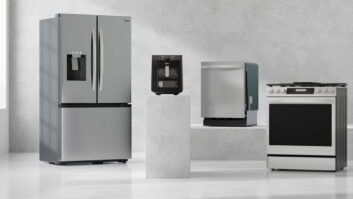Runco’s top dealers and reps were told by the new corporate parent’s home theater business VP to look at the challenges of the cloudy economic horizon and intensified price competition for consumer displays as a glass-half-full opportunity for those concentrating on the high end of the market.
Scott Hix, Planar home theater display products group VP, told Runco’s top-selling dealers at the firm’s annual Mexican Getaway, held here last month, that the impact of the economy is affecting the entry- and middle-market CE segments more than products sold at the high end. He also pointed out that the brunt of today’s economic hardships appear to be sector specific and isolated for the most part in the banking and financial industries.
Despite the economic outlook and price wars in the retail display mass market, Hix said pricing in the low-volume, very-high-end segments of the Runco/Planar/Vidikron lines has remained unchanged.
“Seventy percent of my run rate business in my product category, which is traditionally $10,000 on up, has gone unchanged,” said Hix, who made his first appearance at the annual retreat since Planar acquired the Runco and Vidikron businesses last year. “We are still seeing the wealthy people spending money. God bless them and thank you very much. That is the beauty of the Runco model, and probably why we acquired it. I come from a company [Planar] that felt the pain for this kind of issue because it was more of the middle market space. But in the high end it is still raining.”
Hix pointed out that Runco has not been completely unscathed. “About 30 percent of the Runco business includes a portfolio of products with 720p projectors in the $4,000 to $6,000 range, 1080p projectors in the $8,000 to $10,000 range, and some middle market flat-panel models,” he observed. “That is being pressured, and I am seeing it in terms of declines or flattened sales this quarter. So we are feeling it. But the good news is that it’s a smaller part of our business,” Hix said.
Hix said true home theater is still in its infancy, and that a plasma TV with 5.1 surround is not the full home theater experience that so far remains the province of “the uber-rich and early tech adopters.”
From the industry’s perspective, the front projector category, he said, is still moving “up and to the right” in compound aggregate growth rate for the next three to five years. He said the slope of the chart may be coming down a bit, “but it certainly is a growth space, whereas many other electronics categories are flat or down.”
“The $10,000 space is very consistent. By my best calculations using the analysts’ data, there is about $900 million of spending [in the consumer front projector market] this year that the manufacturers — Sony, Sim2, Sharp, Planar/Runco, etc. — will fight for. About $120 million of that is for the really expensive ones. That slice of the pie seems to be really consistent, and that’s good news for our dealers because that’s where they do their best work.”
Hix continued, “The cross section of target consumers is crossing the chasm between the early adopters into the early majority. There will be lots of pressure on the mid-to-low range, and it’s going to be a race to the bottom.”
Hix said that technological advances, including the shift to 1080p displays, should present opportunities for installers to “open up your customer contacts and go back over the last 10 years, find every single person you sold a 480p or 720p display, because I guarantee they are all uber-rich, and upgrade them, please.”
He added, “If the new people, the middle incomes aren’t building right away because of the economy, those [uber-rich] are the people to go after.”
Similarly, as plasma and LCD TVs become commoditized, new versions that are slimmer, have higher refresh rates and better contrast are coming into the market, presenting additional upgrade opportunities. Newer technologies also bring higher average selling prices, he pointed out.
Hix said the average selling price of front projectors more than $10,000 has gone up over the last three quarters because three-chip 1080p models have come online with higher tickets, replacing older three-chip 720p models.
Meanwhile, Hix pointed to new market segments starting to emerge, including outdoor displays. Runco recently introduced its first weatherproof 42-inch LCD TV and plans to expand the lineup in coming months.
“When you are the ones who are daring enough to carve out a new frontier you harness the profit from the early adopter revenues,” Hix said, comparing outdoor displays today to when Runco’s CineWide projectors first appeared and grew into better than 50 percent of the businesses of dealers who took the plunge.
Hix said to drive the new category, “We have to figure out how to get our heads out of integration and more into the proactive marketing and evangelizing phase.”
Tougher economic climates are the best times for dealers to refocus on educational efforts through CEDIA and the Runco Academy dealer training program, he said, adding that it is critical for dealers to know how to keep selling experience and solutions. “Otherwise you are going to be going up against brands like Epson, and I guarantee you’ll lose because they will undersell you every time,” Hix said. “Times like these will separate the good from the great.”
Addressing Planar’s acquisition of Runco, Hix said “the process has been painful for some and great for others, but daily the process seems to really be improving.”
Planar management carefully observed Runco’s operations between May 23, 2007, and CEDIA in September, only implementing a design phasing process — an engineering approach that produced 11 new platforms. This came on between CEDIA and Christmas to “ensure quality levels and standards of investment stuck as they went out into the market,” Hix said.
At CEDIA, Planar’s teams “went to work” as functional departments, recommending new factory placements, logistics approaches, addressing new IT and telephony systems, and recommending which positions and personnel to recruit to move. “It was like changing tires on a moving car,” he said.
In late January, portions of the company made the shift north to Planar’s base of operations in Portland, Ore.
Hix said Runco was set to handle repair levels of five to 10 units per day, but the new staff levels and operations were only able to address between five and seven repairs a day. The system was tested during the three-week move process, he said. Today, Runco is equipped to handle 15 to 20 repairs per day, he said. The backlog went from 60 to 80 units to more than 220 in a month’s window, but has been cut back to fewer than 100 in the last two weeks. In April it will drop to an all-time low of fewer than 50 units in the repair backlog, he said.












